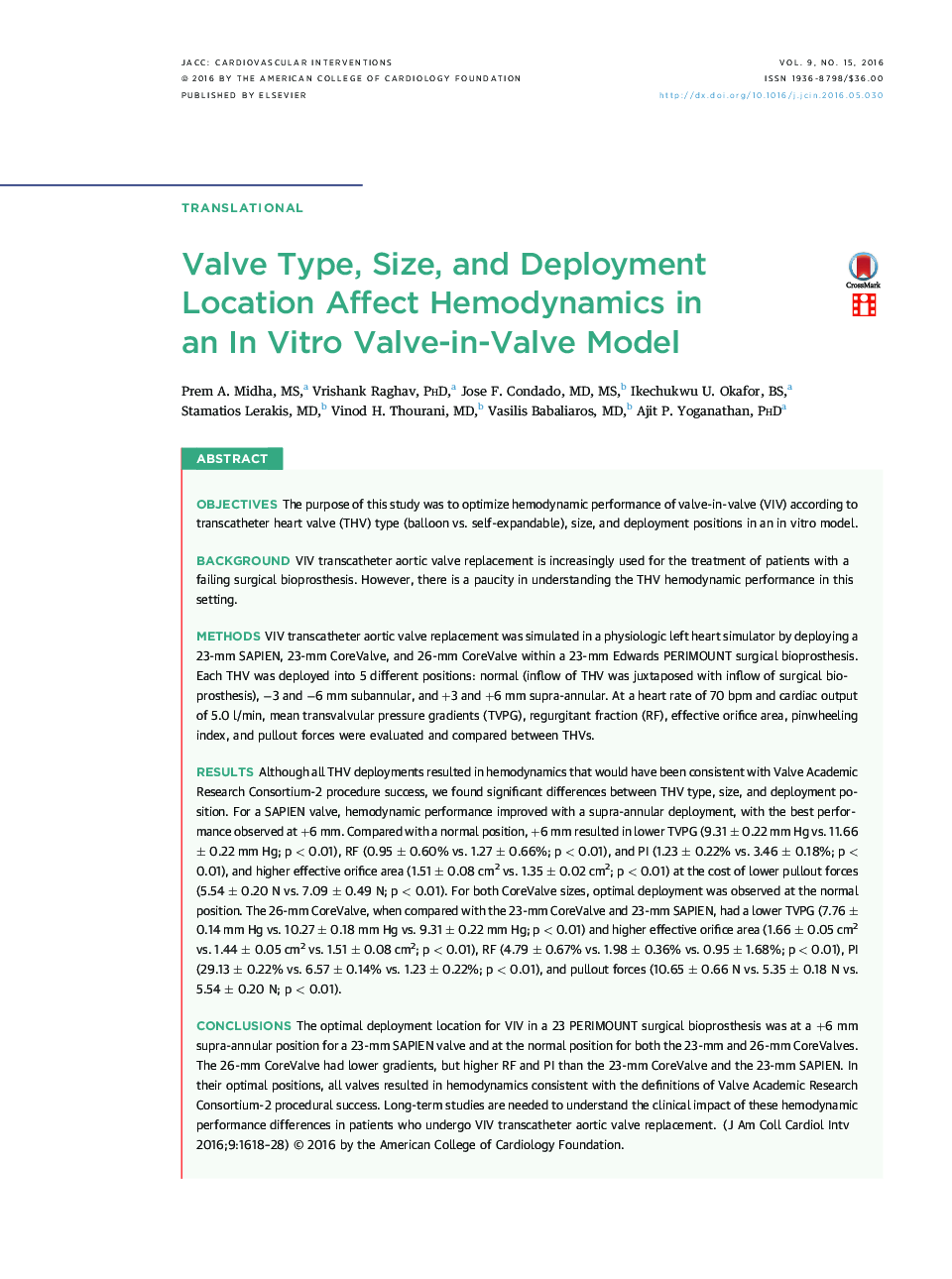| کد مقاله | کد نشریه | سال انتشار | مقاله انگلیسی | نسخه تمام متن |
|---|---|---|---|---|
| 2939581 | 1176993 | 2016 | 11 صفحه PDF | دانلود رایگان |

ObjectivesThe purpose of this study was to optimize hemodynamic performance of valve-in-valve (VIV) according to transcatheter heart valve (THV) type (balloon vs. self-expandable), size, and deployment positions in an in vitro model.BackgroundVIV transcatheter aortic valve replacement is increasingly used for the treatment of patients with a failing surgical bioprosthesis. However, there is a paucity in understanding the THV hemodynamic performance in this setting.MethodsVIV transcatheter aortic valve replacement was simulated in a physiologic left heart simulator by deploying a 23-mm SAPIEN, 23-mm CoreValve, and 26-mm CoreValve within a 23-mm Edwards PERIMOUNT surgical bioprosthesis. Each THV was deployed into 5 different positions: normal (inflow of THV was juxtaposed with inflow of surgical bioprosthesis), −3 and −6 mm subannular, and +3 and +6 mm supra-annular. At a heart rate of 70 bpm and cardiac output of 5.0 l/min, mean transvalvular pressure gradients (TVPG), regurgitant fraction (RF), effective orifice area, pinwheeling index, and pullout forces were evaluated and compared between THVs.ResultsAlthough all THV deployments resulted in hemodynamics that would have been consistent with Valve Academic Research Consortium-2 procedure success, we found significant differences between THV type, size, and deployment position. For a SAPIEN valve, hemodynamic performance improved with a supra-annular deployment, with the best performance observed at +6 mm. Compared with a normal position, +6 mm resulted in lower TVPG (9.31 ± 0.22 mm Hg vs. 11.66 ± 0.22 mm Hg; p < 0.01), RF (0.95 ± 0.60% vs. 1.27 ± 0.66%; p < 0.01), and PI (1.23 ± 0.22% vs. 3.46 ± 0.18%; p < 0.01), and higher effective orifice area (1.51 ± 0.08 cm2 vs. 1.35 ± 0.02 cm2; p < 0.01) at the cost of lower pullout forces (5.54 ± 0.20 N vs. 7.09 ± 0.49 N; p < 0.01). For both CoreValve sizes, optimal deployment was observed at the normal position. The 26-mm CoreValve, when compared with the 23-mm CoreValve and 23-mm SAPIEN, had a lower TVPG (7.76 ± 0.14 mm Hg vs. 10.27 ± 0.18 mm Hg vs. 9.31 ± 0.22 mm Hg; p < 0.01) and higher effective orifice area (1.66 ± 0.05 cm2 vs. 1.44 ± 0.05 cm2 vs. 1.51 ± 0.08 cm2; p < 0.01), RF (4.79 ± 0.67% vs. 1.98 ± 0.36% vs. 0.95 ± 1.68%; p < 0.01), PI (29.13 ± 0.22% vs. 6.57 ± 0.14% vs. 1.23 ± 0.22%; p < 0.01), and pullout forces (10.65 ± 0.66 N vs. 5.35 ± 0.18 N vs. 5.54 ± 0.20 N; p < 0.01).ConclusionsThe optimal deployment location for VIV in a 23 PERIMOUNT surgical bioprosthesis was at a +6 mm supra-annular position for a 23-mm SAPIEN valve and at the normal position for both the 23-mm and 26-mm CoreValves. The 26-mm CoreValve had lower gradients, but higher RF and PI than the 23-mm CoreValve and the 23-mm SAPIEN. In their optimal positions, all valves resulted in hemodynamics consistent with the definitions of Valve Academic Research Consortium-2 procedural success. Long-term studies are needed to understand the clinical impact of these hemodynamic performance differences in patients who undergo VIV transcatheter aortic valve replacement.
Journal: JACC: Cardiovascular Interventions - Volume 9, Issue 15, 8 August 2016, Pages 1618–1628